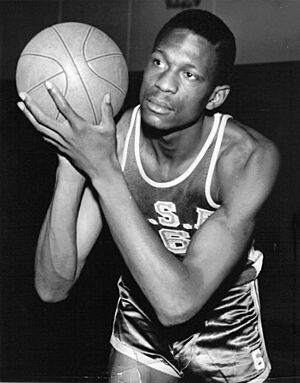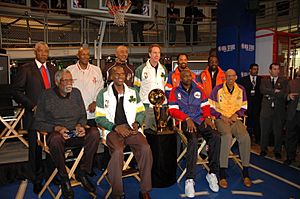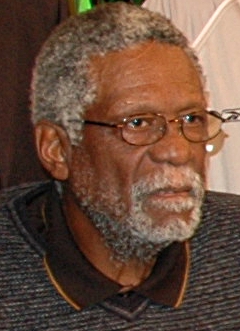Bill Russell facts for kids
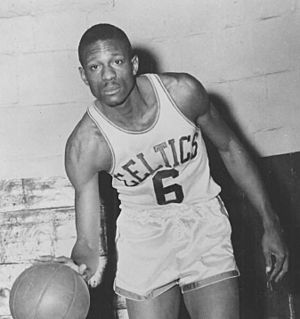
Russell with the Celtics, c. 1960
|
||||||||||||||
| Personal information | ||||||||||||||
|---|---|---|---|---|---|---|---|---|---|---|---|---|---|---|
| Born | February 12, 1934 Monroe, Louisiana, U.S. |
|||||||||||||
| Died | July 31, 2022 (aged 88) Mercer Island, Washington, U.S. |
|||||||||||||
| High school | McClymonds (Oakland, California) | |||||||||||||
| Listed height | 6 ft 10 in (2.08 m) | |||||||||||||
| Listed weight | 215 lb (98 kg) | |||||||||||||
| Career information | ||||||||||||||
| College | San Francisco (1953–1956) | |||||||||||||
| NBA Draft | 1956 / Round: 1 / Pick: 2nd overall | |||||||||||||
| Selected by the St. Louis Hawks | ||||||||||||||
| Pro career | 1956–1969 | |||||||||||||
| Coaching career | 1966–1988 | |||||||||||||
| Career history | ||||||||||||||
| As player: | ||||||||||||||
| 1956–1969 | Boston Celtics | |||||||||||||
| As coach: | ||||||||||||||
| 1966–1969 | Boston Celtics | |||||||||||||
| 1973–1977 | Seattle SuperSonics | |||||||||||||
| 1987–1988 | Sacramento Kings | |||||||||||||
| Career highlights and awards | ||||||||||||||
As player:
As coach:
|
||||||||||||||
| Career NBA statistics | ||||||||||||||
| Points | 14,522 (15.1 ppg) | |||||||||||||
| Rebounds | 21,620 (22.5 rpg) | |||||||||||||
| Assists | 4,100 (4.3 apg) | |||||||||||||
|
Medals
|
||||||||||||||
William Felton Russell (February 12, 1934 – July 31, 2022) was an American professional basketball player. He played as a center for the Boston Celtics in the National Basketball Association (NBA) from 1956 to 1969. He was a five-time NBA Most Valuable Player (MVP) and a 12-time NBA All-Star. Russell was key to the Celtics winning 11 NBA championships during his 13-year career. He and Henri Richard of the National Hockey League share the record for most championships won by an athlete in a North American sports league. Many people consider Russell one of the greatest basketball players ever.
He led the San Francisco Dons to two NCAA championships in 1955 and 1956. He also captained the U.S. national basketball team to a gold medal at the 1956 Summer Olympics.
Russell averaged 15.1 points per game. However, his amazing rebounding, defense, and leadership made him a dominant player. He was 6 ft 10 in (2.08 m) tall with a 7 ft 4 in (2.24 m) arm span. His shot-blocking and man-to-man defense were big reasons for the Celtics' success. Russell was also known for his rebounding. He led the NBA in rebounds four times and had 12 seasons with over 1,000 rebounds. He is second all-time in total rebounds and rebounds per game. He is one of only two NBA players to grab more than 50 rebounds in a game.
Russell was one of the first black players to become a superstar in the NBA. He also coached the Celtics for three seasons (1966–69). This made him the first black coach in the NBA and the first to win a championship. In 2011, Barack Obama gave Russell the Presidential Medal of Freedom. This award honored his achievements in basketball and his work in the civil rights movement.
Russell was inducted into the Naismith Memorial Basketball Hall of Fame in 1975. He was also a founding member of the National Collegiate Basketball Hall of Fame in 2006 and the FIBA Hall of Fame in 2007. He was part of the NBA 25th Anniversary Team (1971), NBA 35th Anniversary Team (1980), 50 Greatest Players in NBA History (1996), and NBA 75th Anniversary Team (2021). In 2009, the NBA renamed the NBA Finals MVP Award in his honor. In 2021, he was inducted into the Naismith Memorial Basketball Hall of Fame again for his coaching. After his death in 2022, the NBA retired Russell's jersey number 6 across the entire league. He is the only player in NBA history to receive this honor.
Contents
Early Life and Basketball Beginnings
Family and Moving West
Bill Russell was born on February 12, 1934, in West Monroe, Louisiana. At that time, many towns in the South had segregation. This meant black and white people were kept separate. Russell's family faced unfair treatment because of their race.
When Bill was eight, his family moved to Oakland, California, during the Second Great Migration. Many black families moved west to find work. They faced tough times and lived in public housing. Bill's mother passed away when he was 12, which was very hard for him. His father then became a steelworker to be closer to his children. Bill looked up to his father and later to basketball star George Mikan.
Learning Basketball Skills
When he was young, Bill Russell struggled with basketball. He was good at running and jumping, but he didn't understand the game well. He was almost cut from his high school team. But his coach, George Powles, saw his potential and encouraged him to practice. Bill worked hard and grew taller, becoming a good player.
Russell became known for his unique defensive style. He learned to jump to block shots, which was different from how defense was usually taught. He studied other players' moves to defend them better.
College Career at San Francisco
Becoming a Defensive Star
College recruiters didn't notice Russell at first. But a recruiter from the University of San Francisco (USF), Hal DeJulio, saw his special talent for the game. Russell accepted a scholarship, seeing basketball as a way to improve his life.
At USF, Russell became the starting center for the San Francisco Dons. Coach Phil Woolpert focused on defense, which was perfect for Russell's skills. Woolpert was also the first coach to start three African-American players: K. C. Jones, Hal Perry, and Russell. Russell used his quickness to play help defense and block shots.
Russell's unique defense made the USF team very strong. They became a top team in college basketball. His play was so dominant that the NCAA changed some rules. For example, they widened the lane and later banned basket interference to make the game fairer against tall players like Russell.
Playing in college wasn't always easy. Russell and his black teammates sometimes faced racist comments, especially when playing away from home. In one case, hotels wouldn't let them stay. The team decided to camp out together, which made them even closer. Russell later said these experiences made him stronger.
Russell led USF to NCAA championships in 1955 and 1956. They won 55 games in a row! He was known for blocking many shots, once denying 13 shots in a single game. Coach John Wooden called him "the greatest defensive man I've ever seen." Russell and K. C. Jones also helped create the "alley-oop" play.
Beyond Basketball: Track and Field
Russell was also a talented track and field athlete at USF. He was excellent at the high jump. In 1956, he was ranked the seventh-best high-jumper in the world. He won several high jump titles and even tied the record for the highest jump at the West Coast Relays.
Professional Basketball Career
Joining the Boston Celtics
Boston Celtics coach Red Auerbach really wanted Russell for his team. He believed Russell's defense and rebounding were exactly what the Celtics needed. The Celtics traded their star player Ed Macauley and Cliff Hagan to the St. Louis Hawks to get Russell. This trade is seen as one of the most important in sports history.
Before his first NBA season, Russell captained the 1956 U.S. men's Olympic basketball team. They won the gold medal at the 1956 Summer Olympics in Australia. Russell was determined to play in the Olympics, even though he could have started his NBA season earlier.
Rookie Season and First Championship
Russell joined the Celtics in December 1956. He averaged 14.7 points and a league-high 19.6 rebounds per game. The 1956–57 Boston Celtics season saw a starting lineup of five future Hall-of-Famers: Russell, Tom Heinsohn, Frank Ramsey, Bill Sharman, and Bob Cousy. Russell's defense transformed the Celtics. They became a strong defensive team that forced many turnovers, leading to easy points.
Russell was known for his "Hey, Bill!" defense. If a teammate needed help, they would shout "Hey, Bill!" and Russell would quickly come to double-team. His shot-blocking was so good that people called his blocks "Wilsonburgers." This allowed his teammates to play more aggressively.
The Celtics finished the 1956–57 season with a 44–28 record. In the 1957 NBA playoffs, Russell had 16 points and 31 rebounds in his first playoff game. The Celtics swept the Syracuse Nationals and reached their first NBA Finals. They faced the St. Louis Hawks. The series went to a thrilling Game 7. Russell made a famous play, blocking a shot by Jack Coleman, which helped the Celtics win 125–123 in double overtime. This was the Celtics' first NBA championship.
In the 1957–58 NBA season, Russell averaged 16.6 points and a record 22.7 rebounds per game. He was voted the NBA Most Valuable Player. The Celtics won 49 games but lost to the Hawks in the 1958 NBA Finals after Russell got a foot injury.
Eight Straight NBA Championships
In the 1958–59 NBA season, Russell continued to dominate rebounding. The Celtics won 52 games and swept the Minneapolis Lakers 4–0 in the 1959 NBA Finals. Lakers coach John Kundla said, "He's the guy who whipped us psychologically."
The 1959–60 NBA season saw the arrival of Wilt Chamberlain, a new rival. Their matchups were called "The Big Collision." While Chamberlain often scored more points, Russell's Celtics usually won. On February 5, 1960, Russell had 51 rebounds in a game, a record at the time. The Celtics won their third championship in four years, beating the Hawks again in the 1960 NBA Finals.
The Celtics continued their winning streak. They won the 1961 NBA Finals against the Los Angeles Lakers. In the 1961–62 NBA season, Russell averaged a career-high 18.9 points and 23.6 rebounds. He won his MVP award. The Celtics won 60 games. In the 1962 NBA playoffs, they again faced Chamberlain's Warriors. Russell held Chamberlain to 22 points in Game 7, helping the Celtics win.
The 1962 NBA Finals against the Los Angeles Lakers was another tough series. Russell had his first career triple-double in Game 6. In Game 7, Russell scored 30 points and grabbed 40 rebounds, leading the Celtics to a 110–107 overtime win.
Even after Bob Cousy retired, the Celtics kept winning. Russell won his fourth MVP award in the 1962–63 NBA season. The Celtics defeated the Los Angeles Lakers again in the 1963 NBA Finals.
In the 1963–64 NBA season, Russell averaged a career-high 24.7 rebounds per game. The Celtics won their sixth straight title, beating the San Francisco Warriors in the 1964 NBA Finals. Russell called this team the best defense of all time.
The Celtics set a league record with 62 wins in the 1964–65 NBA season. Russell won his second straight rebounding title and fifth MVP award. He grabbed 49 rebounds in one game. In the 1965 NBA playoffs, the Celtics faced Chamberlain's Philadelphia 76ers. The series went to Game 7, where John Havlicek made a famous steal to win the game for Boston. The Celtics then won the 1965 NBA Finals against the Lakers.
In the 1965–66 NBA season, Russell led the Celtics to their eighth consecutive championship. They beat Chamberlain's Philadelphia 76ers and then the Los Angeles Lakers in a close Game 7.
Player-Coach and Final Championships
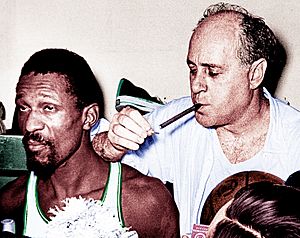
Before the 1966–67 NBA season, Red Auerbach retired as coach. Russell agreed to become the new head coach, making him the first black head coach in NBA history. He told journalists he was chosen because he could do the job, not because of his race.
The Celtics' amazing championship streak ended in 1967. Chamberlain's Philadelphia 76ers beat the Celtics in the Eastern Division Finals. Russell accepted the loss, showing respect to Chamberlain.
In the 1967–68 NBA season, Russell averaged 12.5 points and 18.6 rebounds. In the 1968 NBA playoffs, the Celtics faced the Philadelphia 76ers again. The Sixers led 3–1, but the Celtics made a historic comeback, winning three straight games to take the series. Russell played a key role in Game 7. Boston then beat the Los Angeles Lakers 4–2 in the 1968 NBA Finals, giving Russell his tenth title.
By the 1968–69 NBA season, Russell was 35 and tired. The Celtics had their worst record since 1955. But they still made it to the 1969 NBA Finals against the Los Angeles Lakers, who were favored to win. The series went to Game 7. Russell motivated his team, and they won 108–106, securing his eleventh championship in thirteen years. Russell finished his last NBA game with 6 points, 21 rebounds, and 6 assists. After the game, he comforted Jerry West, the Lakers' star player.
Russell then retired, surprising many. He had achieved so much and decided it was time to move on.
Life After Playing
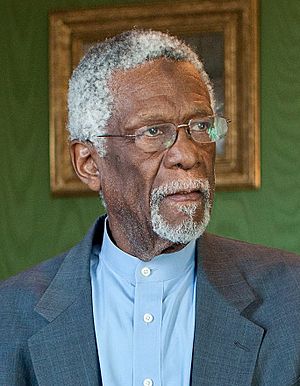
After retiring, Russell worked as a TV commentator. His No. 6 jersey was retired by the Celtics in 1972. He was inducted into the Naismith Memorial Basketball Hall of Fame in 1975, but he didn't attend the ceremony. He later attended his 2021 induction as a coach.
Russell also coached the Seattle SuperSonics (1973–1977) and Sacramento Kings (1987–1988). He helped the SuperSonics reach the playoffs for the first time. He also wrote books and appeared on TV shows.
In 2009, the NBA renamed the NBA Finals MVP Award the Bill Russell NBA Finals Most Valuable Player Award in his honor. In 2011, President Barack Obama awarded Russell the Presidential Medal of Freedom, one of the highest civilian honors in the U.S.
Russell passed away on July 31, 2022, at age 88. NBA Commissioner Adam Silver called him "the greatest champion in all of team sports." Soon after, the NBA retired his No. 6 jersey across the entire league, a unique honor in basketball history.
Achievements and Legacy
Bill Russell is one of the most successful athletes ever. He won eleven NBA championships with the Boston Celtics in thirteen seasons. Two of these were as a player-coach. He changed how defense was played in the NBA. He was the first of only four players to win an NCAA championship and an NBA championship back-to-back. He also won two state championships in high school and an Olympic gold medal.
Russell was the first NBA player to average over 20 rebounds per game for a season, doing it ten times. His 51 rebounds in one game is the second-highest ever. He holds the NBA record for rebounds in one half with 32. In the playoffs, he leads all players in total rebounds (4,104) and average rebounds per game (24.9). He had 40 rebounds in three playoff games. Russell never averaged less than 20 rebounds in any of his thirteen playoff runs. He was known for performing best in important games, winning all eleven deciding games (Game 7s or Game 5s) he played in.
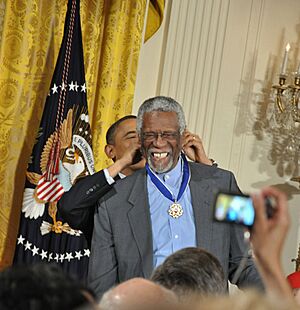
Russell was seen as the ultimate defensive center. He was known for his strong defense, high basketball IQ, and desire to win. He was great at man-to-man defense, blocking shots, and getting defensive rebounds. Wilt Chamberlain said Russell's timing for blocking shots was unmatched. He was also a good passer and could start fast breaks. While he wasn't a high scorer, his defense was his main focus.
Russell won five NBA MVP awards, tied for second all-time with Michael Jordan. He was selected to the All-NBA First Team three times and the Second Team eight times. He was a 12-time NBA All-Star. He was named "Athlete of the Decade" in 1970 by The Sporting News. Many consider him one of the best NBA players ever.
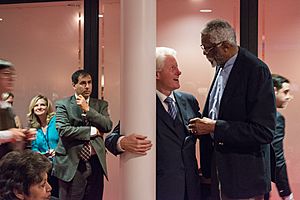
Russell is one of only four players to be on all four NBA anniversary teams: 25th, 35th, 50th, and 75th. In 2009, Slam magazine named him the third-best player of all time.
Former NBA coach Don Nelson said Russell "makes the players around him look better than they are." In 2017, Russell received the NBA Lifetime Achievement Award.
On August 11, 2022, the NBA announced that Russell's No. 6 jersey would be retired across the entire league. This was a first for the NBA, joining Jackie Robinson in baseball and Wayne Gretzky in hockey with this honor.
Statue in Boston

In 2013, a statue of Bill Russell was put up in Boston at City Hall Plaza. It shows him playing, surrounded by 11 pillars. Each pillar represents one of the 11 championships he helped the Celtics win. In 2015, two statues of children were added to honor his work with kids.
West Coast Conference's Russell Rule
In 2020, the West Coast Conference (WCC), where Russell played college basketball, created the "Russell Rule." This rule requires that for every athletic director, senior administrator, head coach, and full-time assistant coach job, at least one candidate from a traditionally underrepresented community must be interviewed. This rule helps promote diversity in sports leadership.
NBA Career Statistics
| Legend | |||||
|---|---|---|---|---|---|
| GP | Games played | GS | Games started | MPG | Minutes per game |
| FG% | Field goal percentage | 3P% | 3-point field goal percentage | FT% | Free throw percentage |
| RPG | Rebounds per game | APG | Assists per game | SPG | Steals per game |
| BPG | Blocks per game | PPG | Points per game | Bold | Career high |
Regular season
| Year | Team | GP | MPG | FG% | FT% | RPG | APG | PPG |
|---|---|---|---|---|---|---|---|---|
| 1956–57† | Boston | 48 | 35.3 | .427 | .492 | 19.6* | 1.8 | 14.7 |
| 1957–58 | Boston | 69 | 38.3 | .442 | .519 | 22.7* | 2.9 | 16.6 |
| 1958–59† | Boston | 70 | 42.6* | .457 | .598 | 23.0* | 3.2 | 16.7 |
| 1959–60† | Boston | 74 | 42.5 | .467 | .612 | 24.0 | 3.7 | 18.2 |
| 1960–61† | Boston | 78 | 44.3 | .426 | .550 | 23.9 | 3.4 | 16.9 |
| 1961–62† | Boston | 76 | 45.2 | .457 | .575 | 23.6 | 4.5 | 18.9 |
| 1962–63† | Boston | 78 | 44.9 | .432 | .555 | 23.6 | 4.5 | 16.8 |
| 1963–64† | Boston | 78 | 44.6 | .433 | .550 | 24.7* | 4.7 | 15.0 |
| 1964–65† | Boston | 78 | 44.4 | .438 | .573 | 24.1* | 5.3 | 14.1 |
| 1965–66† | Boston | 78 | 43.4 | .415 | .551 | 22.8 | 4.8 | 12.9 |
| 1966–67 | Boston | 81* | 40.7 | .454 | .610 | 21.0 | 5.8 | 13.3 |
| 1967–68† | Boston | 78 | 37.9 | .425 | .537 | 18.6 | 4.6 | 12.5 |
| 1968–69† | Boston | 77 | 42.7 | .433 | .526 | 19.3 | 4.9 | 9.9 |
| Career | 963 | 42.3 | .440 | .561 | 22.5 | 4.3 | 15.1 | |
| All-Star | 12 | 28.5 | .459 | .529 | 11.5 | 3.2 | 10.0 | |
Playoffs
| Year | Team | GP | MPG | FG% | FT% | RPG | APG | PPG |
|---|---|---|---|---|---|---|---|---|
| 1957† | Boston | 10 | 40.9 | .365 | .508 | 24.4 | 3.2 | 13.9 |
| 1958 | Boston | 9 | 39.4 | .361 | .606 | 24.6 | 2.7 | 15.1 |
| 1959† | Boston | 11 | 45.1 | .409 | .612 | 27.7 | 3.6 | 15.5 |
| 1960† | Boston | 13 | 44.0 | .456 | .707 | 25.8 | 2.9 | 18.5 |
| 1961† | Boston | 10 | 46.2 | .427 | .523 | 29.9 | 4.8 | 19.1 |
| 1962† | Boston | 14 | 48.0 | .458 | .726 | 26.4 | 5.0 | 22.4 |
| 1963† | Boston | 13 | 47.5 | .453 | .661 | 25.1 | 5.1 | 20.3 |
| 1964† | Boston | 10 | 45.1 | .356 | .552 | 27.2 | 4.4 | 13.1 |
| 1965† | Boston | 12 | 46.8 | .527 | .526 | 25.2 | 6.3 | 16.5 |
| 1966† | Boston | 17 | 47.9 | .475 | .618 | 25.2 | 5.0 | 19.1 |
| 1967 | Boston | 9 | 43.3 | .360 | .635 | 22.0 | 5.6 | 10.6 |
| 1968† | Boston | 19 | 45.7 | .409 | .585 | 22.8 | 5.2 | 14.4 |
| 1969† | Boston | 18 | 46.1 | .423 | .506 | 20.5 | 5.4 | 10.8 |
| Career | 165 | 45.4 | .430 | .603 | 24.9 |
4.7 | 16.2 | |
Head Coaching Record
| Regular season | G | Games coached | W | Games won | L | Games lost | W–L % | Win–loss % |
| Playoffs | PG | Playoff games | PW | Playoff wins | PL | Playoff losses | PW–L % | Playoff win–loss % |
| Team | Year | G | W | L | W–L% | Finish | PG | PW | PL | PW–L% | Result |
|---|---|---|---|---|---|---|---|---|---|---|---|
| Boston | 1966–67 | 81 | 60 | 21 | .671 | 2nd in Eastern | 9 | 4 | 5 | .444 | Lost in Division Finals |
| Boston | 1967–68 | 82 | 54 | 28 | .659 | 2nd in Eastern | 19 | 12 | 7 | .632 | Won NBA championship |
| Boston | 1968–69 | 82 | 48 | 34 | .585 | 4th in Eastern | 18 | 12 | 6 | .667 | Won NBA championship |
| Seattle | 1973–74 | 82 | 36 | 46 | .439 | 3rd in Pacific | — | — | — | — | Missed playoffs |
| Seattle | 1974–75 | 82 | 43 | 39 | .524 | 2nd in Pacific | 9 | 4 | 5 | .444 | Lost in Conference Semifinals |
| Seattle | 1975–76 | 82 | 43 | 39 | .524 | 2nd in Pacific | 6 | 2 | 4 | .333 | Lost in Conference Semifinals |
| Seattle | 1976–77 | 82 | 40 | 42 | .488 | 4th in Pacific | — | — | — | — | Missed playoffs |
| Sacramento | 1987–88 | 58 | 17 | 41 | .293 | (released) | — | — | — | — | — |
| Career | 631 | 341 | 290 | .540 | 61 | 34 | 27 | .557 |
Personal Life
Bill Russell was married to his college sweetheart, Rose Swisher, and they had three children: Karen, William Jr., and Jacob. He later married Dorothy Anstett and then Marilyn Nault. At the time of his death, he was married to Jeannine Russell. He lived in Mercer Island, Washington, for over 40 years. His older brother, Charlie L. Russell, was a famous playwright.
In 1959, Russell became the first NBA player to visit Africa. He was also a member of the Kappa Alpha Psi fraternity.
Earnings and Personality
Russell was one of the first NBA players to earn a lot of money. His first contract in 1956 was worth $24,000. When Wilt Chamberlain became the first NBA player to earn $100,000 in 1965, Russell asked for $100,001 and got it!
Russell was known for his strong sense of pride and dignity. He believed in standing up for himself and what was right. He had a unique, high-pitched laugh that his coach, Red Auerbach, joked about. While he was friendly with teammates, he was often reserved with others, especially journalists.
Rivalry with Wilt Chamberlain

For most of their careers, Russell and his rival, Wilt Chamberlain, were good friends. They even spent holidays together. However, their friendship became strained after the 1969 NBA Finals when Russell made a comment about Chamberlain's injury. They didn't speak for over 20 years until Russell apologized. After that, they became friends again and were often seen together.
Chamberlain usually scored more points and had more rebounds than Russell in their games. But Russell's Celtics teams won more often, beating Chamberlain's teams in seven out of eight playoff series.
See also
 In Spanish: Bill Russell para niños
In Spanish: Bill Russell para niños


